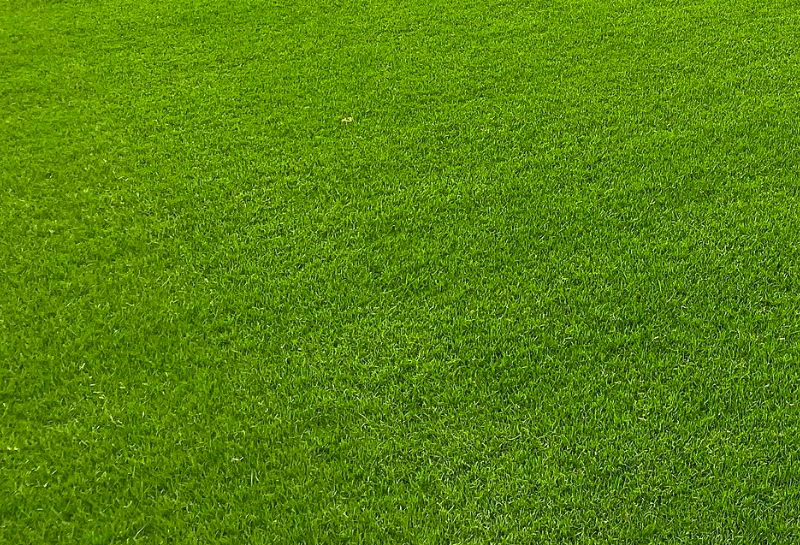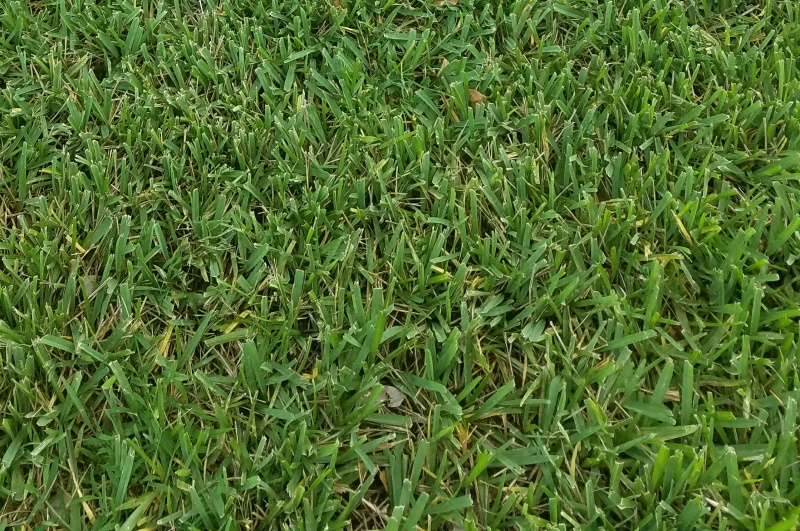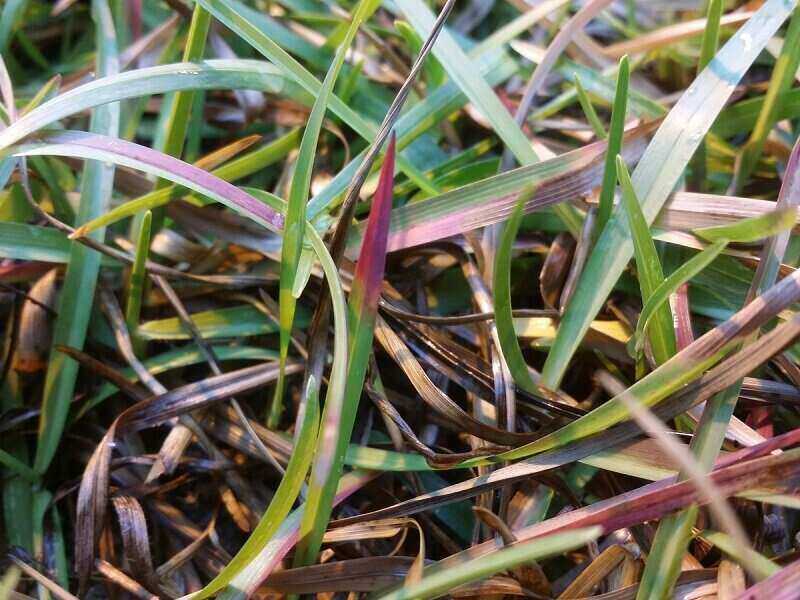
Whether you’ve spent a day behind the wheel at the Broadway Grand Prix or cruising along the Waccamaw River, there’s nothing like relaxing afterward in your own backyard. You don’t want to be staring at a rough lawn, so choose the right grass type to have the green lawn of your dreams.
Myrtle Beach experiences hot summers, strong winds, and salty ocean spray. We chose mostly warm-season grasses (grass types that grow actively in the summer) to survive the heat. We also included cool-season grass that’s appropriate for homeowners in more northern regions of South Carolina.
The best grass types for Myrtle Beach are:

Ty Haller | Flickr | CC BY-SA 2.0
1. Tall fescue
Tall fescue is the only cool-season grass on this list. It goes dormant in hot, dry summer months but grows in spring and fall. It’s a good choice if you live farther north where temperatures may drop too low for warm-season grasses. It tolerates some heat, so it’ll stay green longer into the summer than other types.
This turf has a medium to dark green color with moderate to coarse blades. It grows in bunches that need frequent mowing, but make sure to never remove more than one-third of the blade at once. Because this is a cool-season grass, you’ll need to make sure it’s getting plenty of water during the summer. An automated sprinkler system set to go off in the early morning hours will help.
- Classification: Cool-season grass
- Spreads by: Bunches, sometimes by rhizomes
- Shade tolerance: Moderate
- Drought tolerance: High
- Foot traffic tolerance: High
- Maintenance needs: Low
- Recommended mowing height: 2-3 inches
- Potential for disease: Low; large patch can be an issue if there’s been a lot of heat and humidity
Grass Seed Options:
– Triple-Play Tall Fescue Grass Seed Blend (5000 sq ft)
– Eretz Kentucky 31 K31 Tall Fescue Grass Seed (choose your size)
– Pennington The Rebels Tall Fescue Grass Seed Mix (7 lb.)

Gilba Solutions Pty Ltd | Wikimedia Commons | CC BY-SA 4.0
2. Bermudagrass
Bermudagrass provides a thick lawn that bounces back quickly from heavy foot traffic. Its gray-green blades have rough edges and stems with a purplish color.
This is a great grass type for homes on the coast because it has a high salt tolerance. This means it won’t get injured from that beautiful ocean breeze we love so much. Just be sure to plant it in a sunny area, and dethatch it a couple of times a year to lower the risk of fungal disease.
- Classification: Warm-season grass
- Spreads by: Both rhizomes and stolons
- Shade tolerance: Low; bermudagrass prefers full sun
- Drought tolerance: High
- Foot traffic tolerance: High
- Maintenance needs: Moderate; fertilize during the growth season
- Recommended mowing height: 1-1.5 inches
- Potential for disease: Moderate; more susceptible to fungal diseases with excess shade
Grass Seed Options:
– Pennington Bermudagrass Bare Spot (5 lb. bag)
– Pennington Smart Seed Bermudagrass Mix (8.75-lb. bag)
– Scotts Turf Builder Bermudagrass (10-lb. bag)
– Hancock Seed Co. Bermudagrass (50-lb. bag)

Michelle Selzer | Lawn Love
3. St. Augustinegrass
St. Augustinegrass is a warm-season grass with a medium to dark bluish-green color. Its blades have a coarse texture and grow fast. Like bermudagrass, it has great salt tolerance, but it won’t hold up under drought or heavy traffic. It can also perform better than other warm-season grasses in shade.
When temperatures start to drop in the fall, raise the mowing height half an inch. This will help it get through the colder months because it can maintain more energy in the leaf blade.
- Classification: Warm-season grass
- Spreads by: Stolons
- Shade tolerance: High
- Drought tolerance: Moderate
- Foot traffic tolerance: Moderate
- Maintenance needs: Moderate to high; requires monthly fertilization to thrive
- Recommended mowing height: 3-3.5 inches in the shade and 2.5-3 inches if planted in the sun
- Potential for Disease: Moderate; brown patch and leaf spot can be managed with fungicide; very susceptible to pests, like chinch bugs (dethatch in early spring and fall can help prevent an infestation)
Grass Plug Options:
– Seed Ranch St Augustine Seville Grass Plugs (2 Trays)
– Seed Ranch St Augustine Floratam Grass Plugs (2 Trays)

Pxhere
4. Centipedegrass
Though it’s slow to grow, centipedegrass can develop into a dense turf with a medium texture. Its thick growth pattern helps prevent weeds from establishing, which means less time hunting down crabgrass in your yard.
This is a great low-maintenance option for homeowners who don’t have a lot of energy to devote to caring for their yard. Make sure it’s getting enough water, though — it has a hard time coming back from extended periods of drought. Signs your centipede lawn is experiencing drought include wilting, yellowing, and curling leaf blades. It usually stays green in dormant periods.
Test your soil pH to make sure you have the right conditions for centipedegrass. To do so, you’ll take several samples from different areas in your yard, let them dry overnight, combine, and send them to a lab in your area. Centipedegrass prefers acidic soil within a pH range of 4.5 to 6.0.
- Classification: Warm-season grass
- Spreads by: Above ground stolons
- Shade tolerance: Moderate; tolerates partial shade
- Drought tolerance: Low
- Foot traffic tolerance: Low
- Maintenance needs: Low
- Recommended mowing height: 1.5-2 inches
- Potential for disease: Low
Grass Seed Options:
– Gulf Kist Coated Centipedegrass Seeds (1 lb.)
– Scotts EZ Seed Patch and Repair Centipedegrass (3.75 lbs.)
– TifBlair Centipedegrass (5-lb. bag)
– Pennington Centipedegrass and Mulch (5-lb. bag)
What to consider when choosing your Myrtle Beach lawn
Choosing the right grass type can be overwhelming. Ask yourself these questions about your specific lawn to help you narrow down which one is best for you.
- Do you live in North Myrtle Beach or closer to the North Carolina state line?
- Tall fescue is better if you experience cooler weather.
- Do you have friends and family over often for outdoor get-togethers?
- Bermudagrass can keep up with lots of traffic.
- Do you have a big tree or live at the bottom of a hill?
- St. Augustinegrass tolerates the most shade out of all of these options.
- Is your soil more on the acidic side?
- Centipedegrass actually prefers soil with a lower pH.
If you need a hand getting started or maintaining your lawn, consider contacting a professional landscaper in the Myrtle Beach area.
Main Photo Credit: The ed17 | Wikimedia Commons | CC BY-SA 4.0
Lawn Love participates in the Amazon Services LLC Associates Program, an affiliate advertising program. Lawn Love may earn revenue from products promoted in this article.